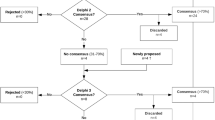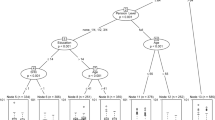Abstract
Study design:
Cross-sectional survey
Objectives:
To describe computer and Internet use (other than for work or study) among people with long-standing spinal cord injury (SCI), examine associations between demographic and lesion characteristics and Internet use, and examine associations between Internet use and mental health, participation, and life satisfaction.
Setting:
Community, The Netherlands
Methods:
Participants were 265 individuals living with SCI for at least 10 years, who were 18–35 at the onset of SCI, aged 28–65 at the time of the study and wheelchair-user. Scales for General and Health-related Internet use were developed.
Results:
Nearly all (97.7%) participants had Internet access and 98.4% of those used it daily or weekly. Of those with tetraplegia, 47.4% had assistive devices for computer use. General Internet use, such as following news and online banking, was very frequent. Websites with information on general health or accessibility were typically visited a few times a year. Three-quarters never visited websites of other individuals with SCI or foreign websites with information on SCI. General Internet use was associated with male gender, younger age, and higher education. Participants with tetraplegia scored higher on Health-related Internet use compared to participants with paraplegia. Health-related Internet use was associated with worse participation, but not with the other psychosocial variables.
Conclusion:
Internet has become part of daily life of people with SCI in the Netherlands. However, only one association between Internet use and indicators of psychosocial functioning was found. Possible underuse of adaptive devices and of SCI-specific websites warrant further investigation.
Similar content being viewed by others
Log in or create a free account to read this content
Gain free access to this article, as well as selected content from this journal and more on nature.com
or
References
Cheatham LP. Effects of Internet use on well-being among adults with physical disabilities. Disabil Rehabil Assist Technol. 2012;7:181–8.
Hogan TP, Hill JN, Locatelli SM, Weaver FM, Thomas FP, Nazi KM, et al. Health Information seeking and technology use among veterans with spinal cord injuries and disorders. PM R. 2016;8:123–30.
O’Riley AA, Rose J, Dalal B. Online support for individuals with spinal cord injuries: an ethnographic investigation. J Spinal Cord Med. 2014;37:179–85.
Matter B, Feinberg M, Schomer K, Harniss M, Brown P, Johnson K. Information needs of people with spinal cord injuries. J Spinal Cord Med. 2009;32:545–54.
Burkell JA, Wolfe DL, Potter PJ, Jutai JW. Information needs and information sources of individuals living with spinal cord injury. Health Info Libr J. 2006;23:257–65.
Celik B, Ones K, Celik EC, Bugdayci DS, Paker N, Avci C, et al. The effects of using the Internet on the health-related quality of life in people with spinal cord injury: a controlled study. Spinal Cord. 2014;52:388–91.
AJAM VanDeursen, van, JAGM Dijk. The digital divide shifts to differences in usage. New Media Soc. 2014;16:507–26.
Drainoni ML, Houlihan B, Williams S, Vedrani M, Esch D, Lee-Hood E, et al. Patterns of Internet use by persons with spinal cord injuries and relationship to health-related quality of life. Arch Phys Med Rehabil. 2004;85:1872–9.
Goodman N, Jette AM, Houliban B, Williams S. Computer and Internet use by persons after spinal cord injury. Arch Phys Med Rehabil. 2008;89:1492–8.
Houlihan BV, Drainoni ML, Warner G, Nesathurai S, Wierbicky J, Williams S. The impact of Internet access for people with spinal cord injuries: a descriptive analysis of a pilot study. Disabil Rehabil. 2002;25:422–31.
Tsai IH, Graves DE, Lai CH, Hwang LY, Pompeii LA. Association of internet use and depression among the spinal cord injury population. Arch Phys Med Rehabil. 2014;95:236–43.
Miller SM. The effect of frequency and type of Internet use on perceived social support and sense of well-being in individuals with spinal cord injury. Rehabil Couns Bull. 2008;51:148–58.
Van der Woude LH, de Groot S, Postema K, Bussmann JB, Janssen TW, ALLRISC. et al. Active LifestyLe Rehabilitation interventions in aging spinal cord injury (ALLRISC): a multicentre research program. Disabil Rehabil. 2013;35:1097–103.
Adriaansen JJE, van Asbeck FWA, Lindeman E, van der Woude LHV, de Groot S, Post MWM. Secondary health conditions in persons with a spinal cord injury for at least 10 years: design of a comprehensive long-term cross-sectional study. Disabil Rehabil. 2013;35:1104–10.
Central Bureau of Statistics. Statline. Retrieved 10 December 2018, from https://opendata.cbs.nl/#/CBS/nl/dataset/83429NED/table?ts=1544779223982.
Kirshblum SC, Burns SP, Biering-Sorensen F, DonovanW, Graves DE, Jha A, et al. International standards for neurological classification of spinal cord injury (revised 2011). J Spinal Cord Med. 2011;34:535–46.
Ware JE, Sherbourne CD. The MOS 36-itme short-form health survey (SF-36). I. Conceptual framework and item selection. Med Care. 1992;30:473–83.
Van Leeuwen CMC, van der Woude LHV, Post MWM. Validity of the mental health subscale of the SF-36 in persons with spinal cord injury. Spinal Cord. 2012;50:707–10.
The WHOQOL Group. The World Health Organization Quality of Life Assessment (WHOQOL): development and general psychometric properties. Soc Sci Med. 1998;46:1569–85.
Geyh S, Fellinghauer BAG, Kirchberger I, Post MWM. Cross-cultural validity of four quality of life scales in persons with spinal cord injury. Health Qual Life Outcomes. 2010;8:94.
Post MW, van der Zee CH, Hennink J, Schafrat CG, Visser-Meily JM, van Berlekom SB. Validity of the Utrecht scale for evaluation of rehabilitation-participation. Disabil Rehabil. 2012;34:478–85.
Van der Zee CH, Post MWM, Brinkhof MW, Wagenaar RC. Comparison of the utrecht scale for evaluation of rehabilitation-participation with the ICF measure of participation and activities screener and the who disability assessment schedule II in persons with spinal cord injury. Arch Phys Med Rehabil. 2014;95:87–93.
Caltenco HA, Breidegard B, Jönsson B, Andreasen Struijk LNS. Understanding computer users with tetraplegia: Survey of assistive technology users. Int J Hum Comput Interact 2012;28:258–68.
Pouplin S, Roche N, Vaugier I, Cabanilles S, Hugeron C, Bensmail D. Text input speed in persons with cervical spinal cord injury. Spinal Cord. 2016;54:158–62.
Bea-Muñoz M, Medina-Sánchez M, Flórez-García MT. Quality of websites with patient information about spinal cord injury in Spanish. Spinal Cord. 2016;54:540–5.
Manns PJ, May LA. Perceptions of issues associated with the maintenance and improvement of long-term health in people with SCI. Spinal Cord. 2007;45:411–9.
Coulter EH, McLean AN, Hasler JP, Allan DB, McFadyen A, Paul L. The effectiveness and satisfaction of web-based physiotherapy in people with spinal cord injury: a pilot randomised controlled trial. Spinal Cord. 2017;55:383–9.
Verwer JH, van Leeuwen CM, Bolier L, Post MW. Feasibility of an online well-being intervention for people with spinal cord injury: a pilot study. Spinal Cord. 2016;54:473–7.
ALLRISC Group
S. de Groot5,6, TWJ Janssen7, H. Bussmann8, C. Smit5, M. Sloots5, D. van Kuppevelt9, H. Rijken9, W. Faber10, L. Valent10, G. Snoek11, M. Schuitemaker11, F. Woldring2, H. Bongers12, S. Slangen12, M. Wynants12, T. Sluis13, R. Broeksteeg13, C. Dijkstra3, P. Luthart3
Author contributions
MWMP obtained funding for the study, analyzed the data and wrote the final manuscript. JMPL performed initial data analysis, wrote the first draft and provided feedback on the manuscript. MT and GJS contributed to the data collection and provided feedback on the manuscript. LHVvdW obtained funding for the study, coordinated the ALLRISC research program and provided feedback on the manuscript. JJEA wrote the study protocol, coordinated the data collection and provided feedback on the manuscript.
Funding
ALLRISC is sponsored by ‘‘Fonds NutsOHRA’’ under the responsibility of the Netherlands Organization for Health Research and Development (www.ZonMW.nl), Project number 89000006.
Author information
Authors and Affiliations
Consortia
Corresponding author
Ethics declarations
Conflict of interest
The authors declare that they have no conflict of interest.
Ethical approval
The research protocol was approved by the Medical Ethics Committee of the University Medical Center Utrecht (protocol number 11–156/E; NL36394.041.11, version 4). We certify that all applicable institutional and governmental regulations concerning the ethical use of human volunteers were followed during the course of this research.
Additional information
Publisher’s note: Springer Nature remains neutral with regard to jurisdictional claims in published maps and institutional affiliations.
Rights and permissions
About this article
Cite this article
Post, M.W.M., Leenders, J.M.P., Tepper, M. et al. Computer and internet use among people with long-standing spinal cord injury: a cross-sectional survey in the Netherlands. Spinal Cord 57, 396–403 (2019). https://doi.org/10.1038/s41393-018-0237-1
Received:
Revised:
Accepted:
Published:
Issue date:
DOI: https://doi.org/10.1038/s41393-018-0237-1
This article is cited by
-
Developing guiding principles for technology-based rehabilitation program by engaging people with motor incomplete tetraplegia
Journal of NeuroEngineering and Rehabilitation (2022)
-
Guided internet-delivered cognitive-behaviour therapy for persons with spinal cord injury: a feasibility trial
Spinal Cord (2020)
-
How individuals with spinal cord injury in the United States access and assess information about experimental therapies and clinical trials: results of a clinical survey
Spinal Cord Series and Cases (2020)



